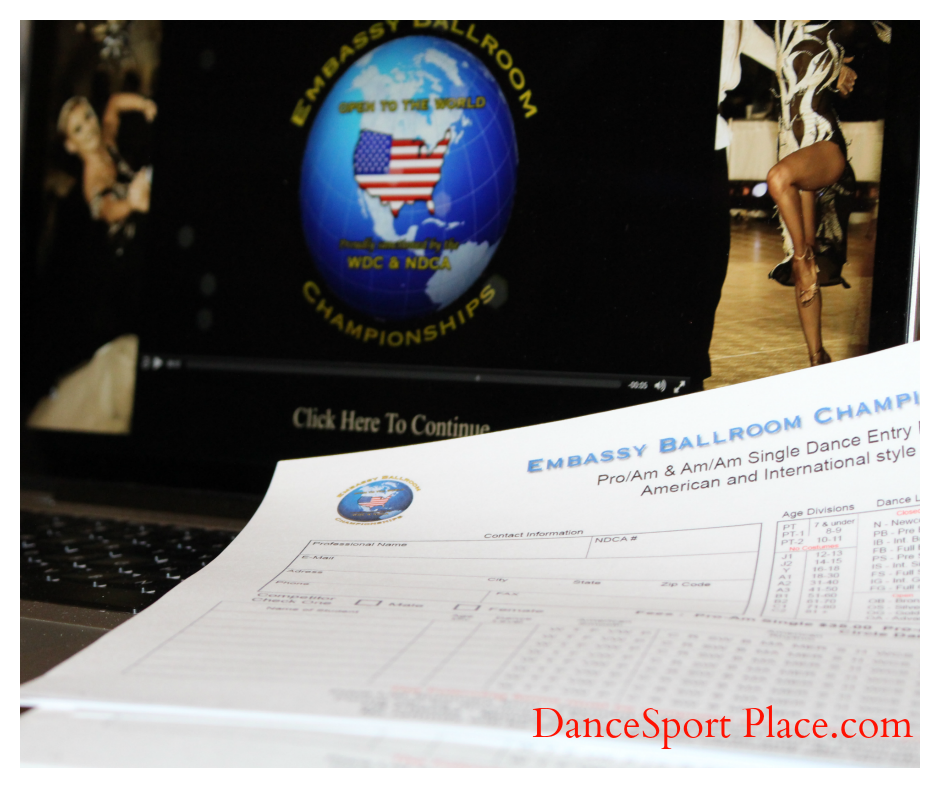Competing in ballroom is expensive.
I know, that’s an understatement.
It’s even more expensive when you’re a student competing in pro-am.
Competition entry fees and tickets, travel and hotel expenses, your teacher’s expenses, costumes, hair and makeup – it all adds up very quickly.
Not to mention all of the lessons you need to prepare for the competition.
Some costs can be offset. Your teacher’s expenses are split amongst the students going to the competition. If the competition is within driving distance, you can carpool with other students. You can also split a hotel room with other students.
But what if you’re the only student going? You have to pay for all of your AND your teacher’s expenses! YIKES.
It can be done though. I know because I’m doing it for the United States Dance Championships (USDC) in September.
I’m not independently wealthy or married to a rich husband, and I’m not charging everything to a credit card to worry about later.
Want to know my secret?

Here are my tried-and-true tips and strategies for saving money when you’re the only student going to an away competition:
1) Plan ahead.
Once you decide to do an away dance competition, start budgeting and planning for it right away. I started planning for USDC over 9 months ago.
Make a list of known expenses like:
- entry fees
- tickets to the session you’ll dance in (remember – yours and your teacher’s)
- hair/makeup, costume rental
- your teacher’s pro fee
- travel, hotel, and food
Look at the competition’s website for entry fee costs and ticket prices. If they don’t have the entry fees listed for this year, see if last year’s costs are still posted. If all else fails, use $40/entry as an estimate (unless you’re budgeting for USDC, in which case, use $50).
If you’re going to fly, look up flight prices to get a general idea of how much you’ll need to budget for travel.
Find out if there is a special room rate at the hotel for the competition. Putting all of these numbers together ahead of time is critical.
2) Start saving…yesterday.
Once you have a general idea of how much you’ll need for the competition, start putting that money aside. I usually transfer money to a savings account separate from my main checking account, so I don’t even see the money when I check my account balance.
I’ve also taken the money out as cash and kept it in a safe place at home. Being able to count PHYSICAL CASH and see how my little pile grew as I put more cash aside kept me motivated.
Even if you can only put a little aside, every bit helps. Just think, once you have $40 saved, that’s one entry paid for!
3) Spread out the expenses.
Coming up with $3,000 over the course of 6 months is a lot easier than all at once.
Planning WHEN you’ll need to pay is just as important as planning WHAT you’ll need to pay.
Along with a spreadsheet of expenses, make a projected budget spreadsheet. Between now and the competition, keep track of when you get paid, when bills are due, and especially when the entry fees are due.
Add a column with the running balance in your bank account and you’ll know what paychecks need to go toward paying rent or credit card bills and what paychecks will have some extra money in them to put toward the competition.
Insert the dates of your other competition expenses, such as when you’ll need to pay your teacher’s fee or rent your costume. Don’t forget to include any lesson payments.
Spread out the big expenses like flights and entry fees so they don’t fall in the same month. You can even plan on booking your flight separately from your teacher’s flight if you need to.
You will also be able to look at what happens to your account balance in two months if you were to spend some extra money on a night out or new clothes right now.
4) Shop around.
Flight and hotel prices vary so much, but luckily there are a ton of websites that will search all of the different airlines and hotels for you to find the best price.
For flights:
if you’re traveling to or from a metropolitan area, look at multiple airports in the area. If your schedule is flexible, look at different travel dates. Thursday is a cheaper travel date than Friday, for example.
Also pay attention to WHEN you book your flights.
Somewhere around 50 to 60 days before your departure date is said to be one of the best times to book travel. Flight prices often drop at the beginning of the week (Monday, Tuesday) and rise over the weekend.
After you do book your flight, keep checking prices!
You can cancel your reservation for a full refund within 24 hours with most airlines, so if the price drops the day after you book, cancel and rebook. Many airlines also offer some kind of price matching in case prices change drastically shortly after you book; check with your airline to find out the exact rules.
For your hotel:
don’t assume the competition rate at the host hotel is the best rate for that hotel or for the area. Go to those discount travel sites again and see what rates they come up with. Look at a map and see what hotels are within walking distance and look at their rates.
You could save yourself $50-$100 per night just by staying at the hotel next door to the one hosting the competition.
For costumes:
For women like me who can’t afford to buy a dress, the other option is renting (assuming you don’t have the skills to make your own).
Dress rentals can vary in price, but you don’t necessarily have to rent from a dressmaker. Ask around. Maybe there is a teacher or another student who has a dress in their closet that they haven’t worn for awhile and would be willing to rent to you for less than the normal price.
Same goes for jewelry. I have borrowed earrings and/or hair pieces for almost all of my competitions.

5) Consider packages carefully.
Many competitions offer packages for competitors that include a discount on entry fees, tickets to sessions, and sometimes meals and hotel.
Consider these carefully.
Unless you are doing a larger number of entries, you can end up paying MORE than if you paid for everything separately.
For example, one of the competitions I attended last year offered a series of packages, the cheapest of which was $300. Entry fees were reduced from $40 per entry to $30 per entry and my ticket to my session was included.
However, I was only entering 12 single dances plus a scholarship. When I ran the numbers, I would have paid $75 more on package. It wouldn’t have saved me money unless I did 20 or more entries, which I couldn’t afford.
Also, pay attention to what nights are included on packages that include the hotel. If you need more nights or different nights, you will have to cover those on top of paying for the package.
Same goes for packages including meal vouchers. The meals are served at specific times and if you’re going to be dancing while they’re serving breakfast, then your voucher will be wasted.
6) Don’t pay late fees, do pay CASH.
Competitions often charge a late fee for entries and fees submitted after the deadline. So keep track of the deadline and make sure you pay on time.
There is a certain risk you take in paying ahead of time because you aren’t likely to get a refund from the competition if something happens and you have to drop out. If it’s a risk you’re not willing to take, then make sure you plan for that extra $50.
Usually, you can pay by check before the event. If you’re paying at the competition, most only accept cash.
The competitions that DO accept credit cards will charge a processing fee that is a percentage of your total. And then after that, you have to make sure you pay off your credit card balance so you don’t end up paying interest on your entry fees as well.
7) Enter a scholarship with a cash prize.
This tip is a little after-the-fact and obviously is not a guarantee, but if you’re paying entry fees, you may as well include some for dances that may get you a small return.
Scholarship/multi-dance entries usually cost the same per dance as the single dances.
So if you don’t place high enough to win any money, you’re in the same place financially as if you had just entered single dances.
But if there is a chance of taking home some cash to help offset the expense, why not go for it?
8) Don’t order room service.
Food at competition is the easiest expense to reduce. Do some grocery shopping before you leave and plan your meals, instead of just ordering room service or going to the restaurant in the hotel.
Check to see what your hotel room comes with, such as a coffee maker and a fridge. Look up hotel room hacks for tips on making all sorts of meals using the items provided in a hotel room. And remember, you’re going to stuck in the ballroom for most of a day!
Bring easy-to-eat snacks with you such as trail mix or nuts, baby carrots, dried fruits, protein bars, etc. that are inexpensive (or you can buy on sale before you leave) and will keep you energized. Peanut butter and jelly sandwiches anyone?
If you’re like me and need multiple cups of caffeine through the day, bring a travel mug and make extra coffee/tea in your hotel room to take with you to the ballroom, instead of running out to the coffee shop in the hotel lobby.
Focus on the Dancing, Not the Dollars.
I have used EVERY ONE of these tips myself in order to afford ballroom competitions. If you’ve planned ahead, you’ll be able to enjoy the event more without thinking about bills when you get home.
When you’re passionate about dancing, there’s not much you won’t do in order to get out on that floor!
Bottom line:
With some careful planning and a little sacrifice, you can make it happen.
Happy dancing!






Thank you for the realistic info. I also have the self doubt and anxiety and have not been able to compete yet but I’m trying…..:)
Glad you liked it, Donna! It helps a lot with the planning to be honest about the costs and what it takes to make a comp financially do-able. If you’re having anxiety about dancing in a comp, please check out some of our other blogs on this subject. After you’ve taken Katie’s advice for planning your budget, don’t wait for the perfect time to “feel ready”. The sooner you get on the floor, the sooner you’re on your way to defeating any self-doubt! Good luck and see you on the floor!
Right there with you, Donna! I fight my anxiety and doubt every day, but the more I push myself, the easier it gets! Check out my latest post on thegirlwiththetreetattoo.com, I talk about how I’m dealing with my “demons.” And feel free to contact me directly (form is on my site)!
Katie…thk u so much 4 this blog!!!! It has been most helpful. I will be dancing in October with my Coach Felipe Telona. Definitely will stay tuned of your blog writing! Thx 2 DANCESPORTPLACE for your blog! I just won the book raffle/give away
“Ballroom Dance & Glamour.”
See you in the Ballroom!
😉
Liaette Lee Baca
Katie has done a great job to really break down how to make comps affordable. So glad it was helpful, Lisette! Congratulations on winning our recent book giveaway. You’re on a winning streak and ready to rock the comp in October. Good luck and we’ll see you on the floor!
So glad it was helpful to you! Congrats on winning the giveaway. 🙂
I like your comments on saving money on ballroom dancing. I have been in pro-am comps since my first in 2007. At first I only did the local-once a year comp. After about
2.5 years. I traveled a bit. Twice out of state and also at a near by metropolis. I moved recently to another state and found another coach, who is more expensive, but teaches more technique than i found in my previous coaches. His comp fees are quite expensive, and he charges per day. Therefore, one feels compelled to do as many entries as you can afford to justify the fees. I agree, the finances can add up!
My teacher’s fee has a similar structure, so I understand trying to find the balance between wanting to do more entries to make it more worthwhile and being able to afford those additional entries! I budgeted to dance a couple extra at USDC compared to what I normally do since I am flying across the country. But a couple was all the extra I could afford. We do what we have to! I’m glad you liked the article. Hopefully it helps you at future comps!
As a former FADS student and now an independent competitior…another way to save money is to veer away from Pro-AM! Always be on the lookout for a partner and when you dance Am-Am you save money on lessons, travel, fees, AND in my opinion when training as an independent, you become more self assured and knowledgeable about the sport because you are not dependent on a professional to “put” you where you need to be.
Just sharing my experience.
PS LOVE LOVE LOVE the back piece!!!
Finding someone compatible can be difficult, but dancing amateur definitely saves on the pocketbook! Thanks for comment and sharing your insight, Elena!